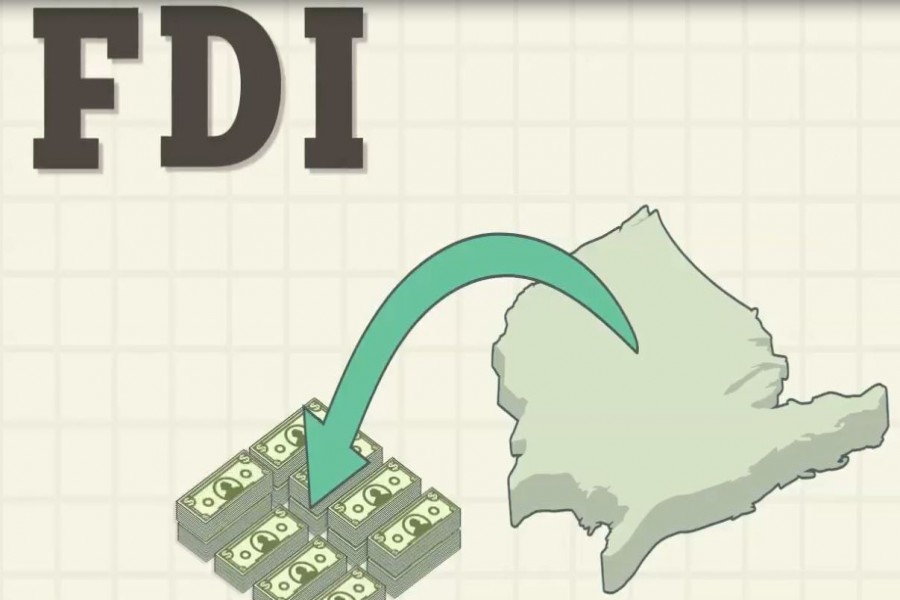
Published :
Updated :

One of the main downsides of Bangladesh's economy is the low level of foreign direct investment (FDI). Various favourable policies and measures promise to attract a higher amount of FDI. Nevertheless, the annual inflow of investment capital is still low compared to many other developing countries. The ratio of FDI in terms of the gross domestic product (GDP) is below 1.0 per cent, indicating that the economy's growth is not supported by foreign investment. The ratio is 1.80 per cent in Indonesia and 2.4 in India.
The inflow of annual average FDI in the last decade stood at around US$2.45 billion in the country. The highest influx of FDI was recorded in the fiscal year 2018-19 (FY19). According to the statistics from Bangladesh Bank, the amount was $3.89 billion. Due to the pandemic originating from Covid-19, FDI declined in FY20 to $2.37 billion. It, however, started to rebound in the next year when the inflow stood at $2.50 billion. The net incomings in the first nine months of FY22 reached $2.65 billion. Though complete data are yet to be available, preliminary estimation hinted that FDI in the last fiscal year (FY22) could likely cross $3.50 billion, the second-highest amount so far.
There is a set of traditional arguments in favour of higher FDI. For resource-scare countries, foreign investment can act as a vehicle to build up physical capital, generate employment opportunities and develop productive capacity and human-resource skills through technology transfer. FDI also helps these countries to integrate with the global economy. Nowadays, FDI is also considered a vital tool for improving natural and social environments in the host countries by way of transferring green technology and promoting better corporate social responsibilities.
However, the latest half-yearly report on FDI prepared by Bangladesh Bank says: "Bangladesh has been quite successful in attracting FDI inflows since the inception of economic reform in 1995. The inflow of FDI has contributed significantly to the economic development of Bangladesh."
The assertion is not well-substantiated. For various reasons, Bangladesh has largely failed to attract desired investment from abroad. Take the example of the projected FDI in the seventh five-year plan (7FYP). During FY16-FY20, the yearly average FDI was recorded at $2.66 billion--far below the annual average target of $6 billion. The significant shortfall probably drives the policy planners to skip any such projection in the 8FYP.
The central bank report also adds: "Bangladesh has become one of the most attractive emerging markets globally." Mentioning that the gross FDI inflow from 2017 to 2021 was US$ 18.48 billion, and net FDI stood at US$ 14.10 billion, it also claims: "This flow of funds over the years has helped the country in advancement of technology, skilling up gradation, employment generation, better infrastructure and management."
Though some positive impacts of FDI on growth are already there, that is not optimal for the country's economic advances.
Though touted as 'one of the most attractive emerging markets,' yet the country is one of the worst performers in the Greenfield FDI Performance Index, prepared by FDI Intelligence. The seventh edition of the index, released last week, showed that Bangladesh is the third-worst performer, preceded by China and Japan. Pakistan stands fourth in this ranking.
From the classical economic perspective, FDI is an effective element to support a country's balance of payments (BoPs). FDI brings long-term foreign capital, generally in the much-coveted US dollar, to finance the gap in capital shortfall. Being an essential element of the financial account of BoP, the inflow of FDI helps to fund the long-term deficit of the country's external transactions with the rest of the world.
Foreign investment and foreign credit are two core elements of the financial account of BoP. In Bangladesh, foreign credit is the primary source of medium- and long-term external finance.
In the last fiscal year (FY22), the country's financial account posted a surplus of $13.66 billion against an $18.69 billion deficit in the current account. Thus, overall deficit in the BoP stood at $5.38 billion (after adjusting the $188 million surplus in the capital account and deducting $530 million in errors and omissions). To put it simply, foreign investment and credit have financed a significant portion of the current-account deficit. Nevertheless, the amount of external term finance was insufficient to cover the total shortfall, leaving the overall shortage in BoP.
Now, foreign credits contribute more than two-thirds of the financing from the financial account. It also shows the country's reliance on external credit to finance the budget deficit due to the low amount of foreign investment. If there had been a higher inflow of foreign investment, the gap in the current account and the overall balance would have been lower.
This simple math is not simple in the real world as many factors are involved with FDI and its actual impact on BoP. For instance, in many cases, a higher inflow of FDI pushes imports of goods as the foreign investors need to bring industrial raw materials and intermediary products from abroad to run their factories. This, in turn, puts pressure on the current-account balance. So, higher FDI is not necessarily an answer to ease the immediate stress on BoP. Instead, it needs to be seen from a long-term perspective.
Though FDI helps to support the BoP, a consistent and higher inflow is necessary, whereas, in Bangladesh, the influx of FDI is mainly steady yet low. That's why its overwhelming impact on BoP is not visible. However, the excessive current pressure on the country's BoP is a reminder that well-crafted effort is necessary to net more sustainable FDI in the long run.


 For all latest news, follow The Financial Express Google News channel.
For all latest news, follow The Financial Express Google News channel.